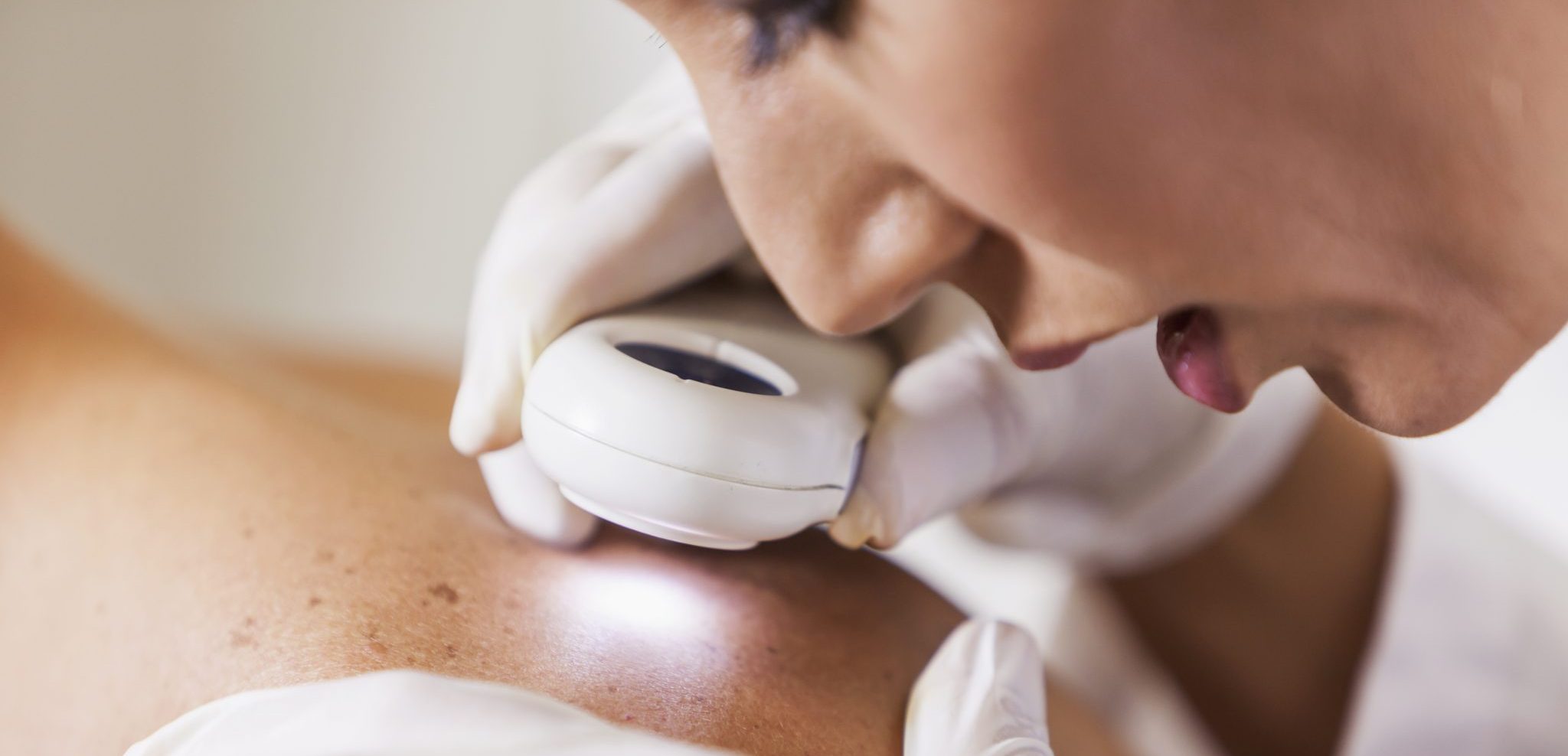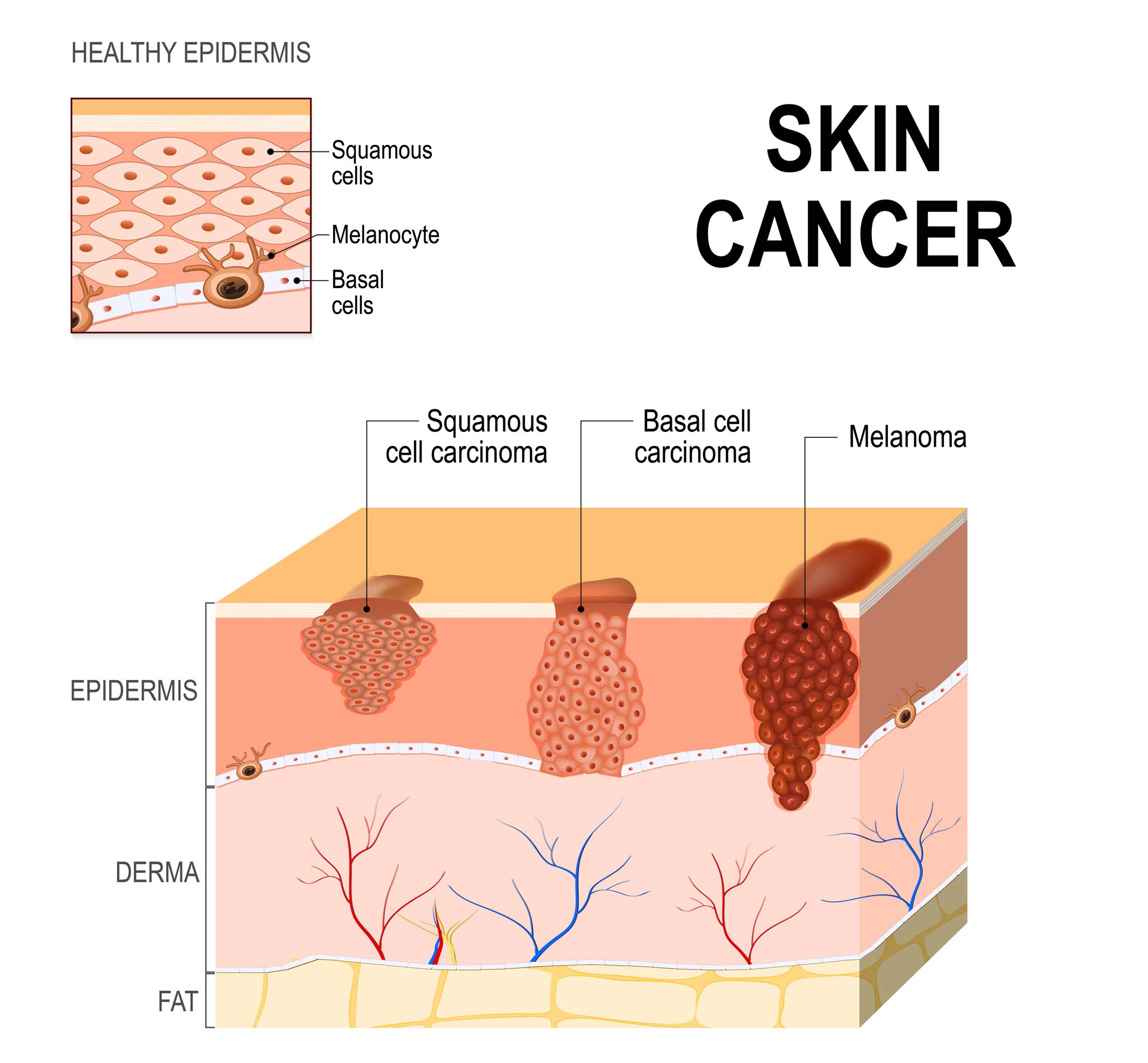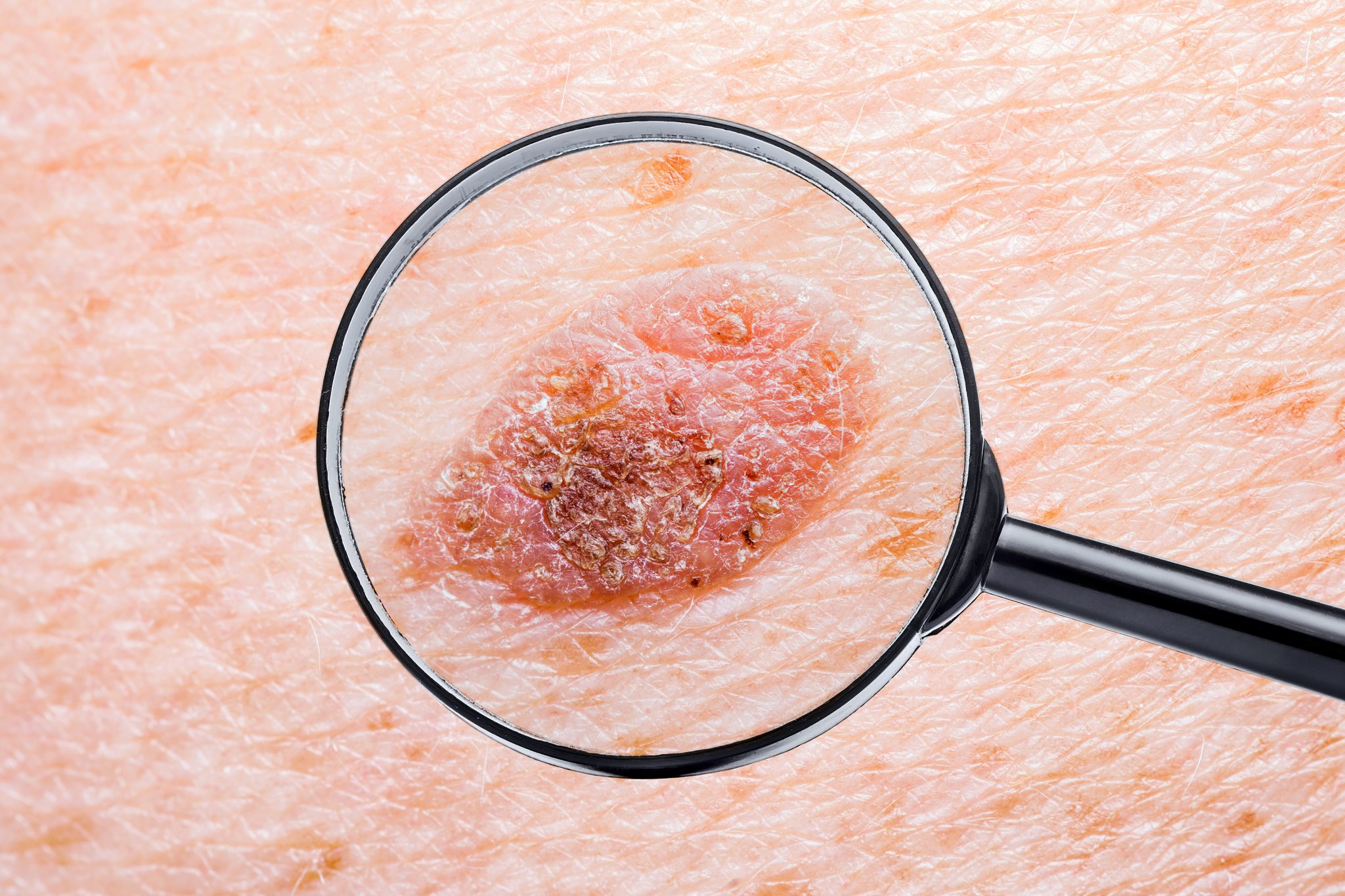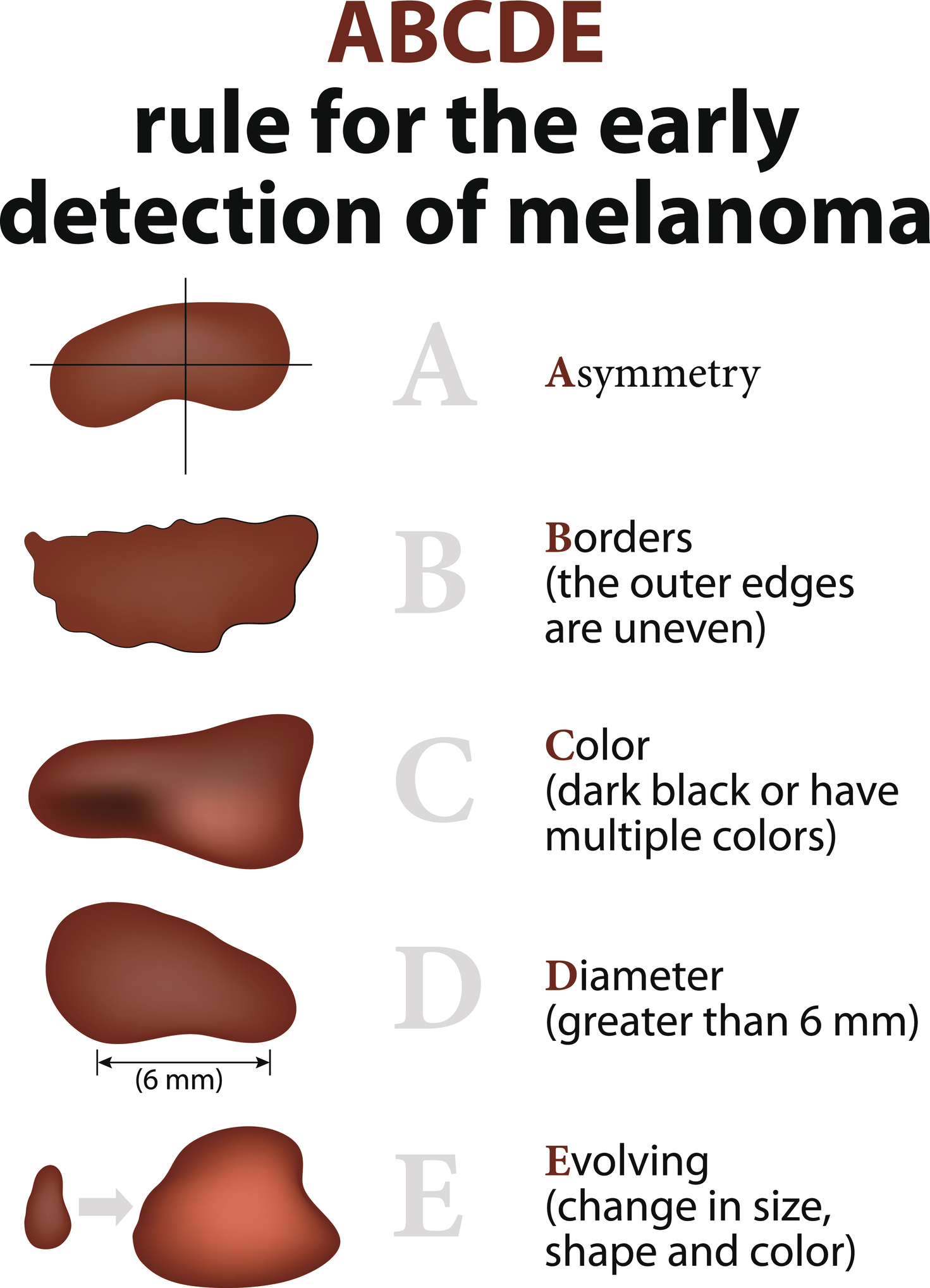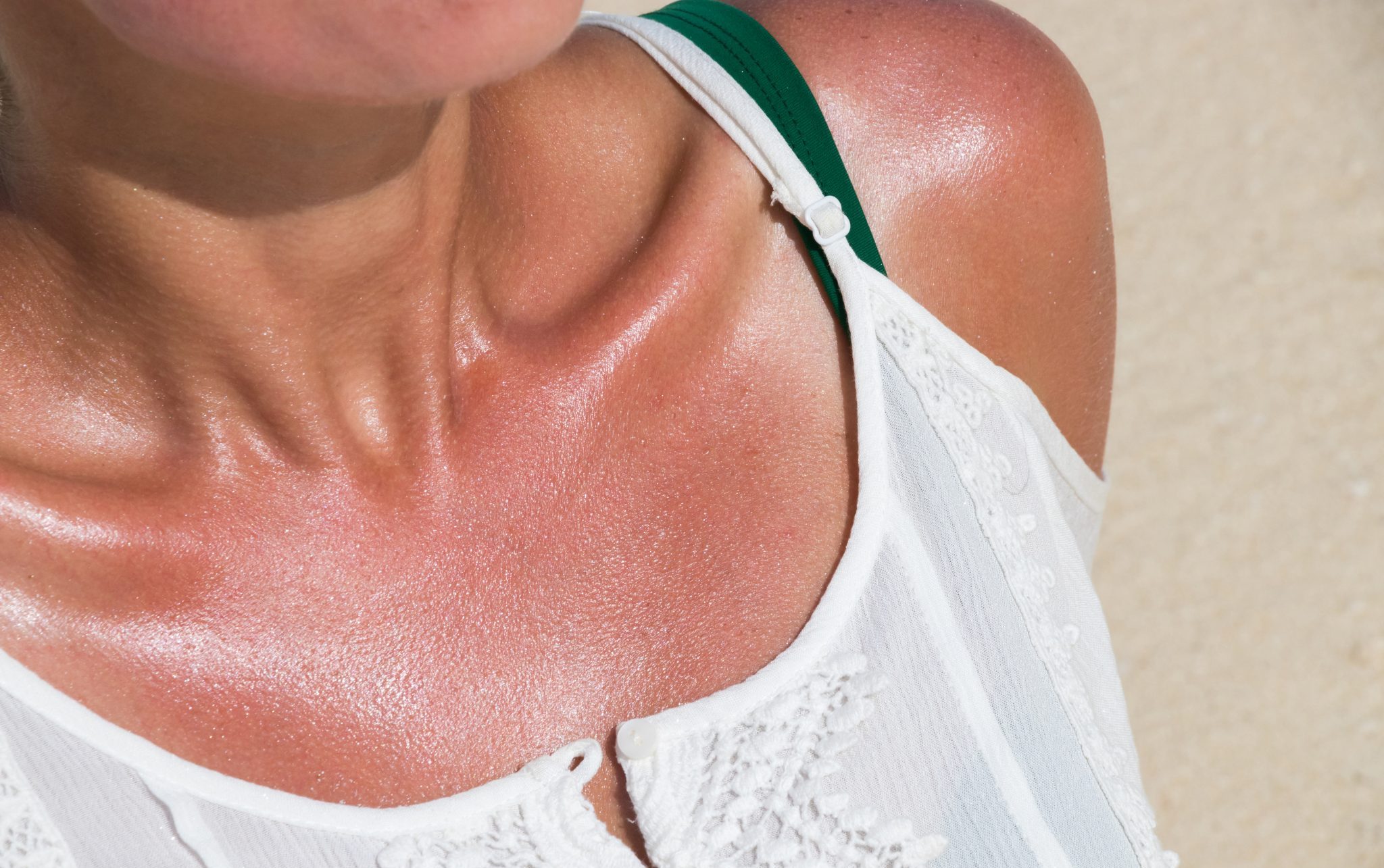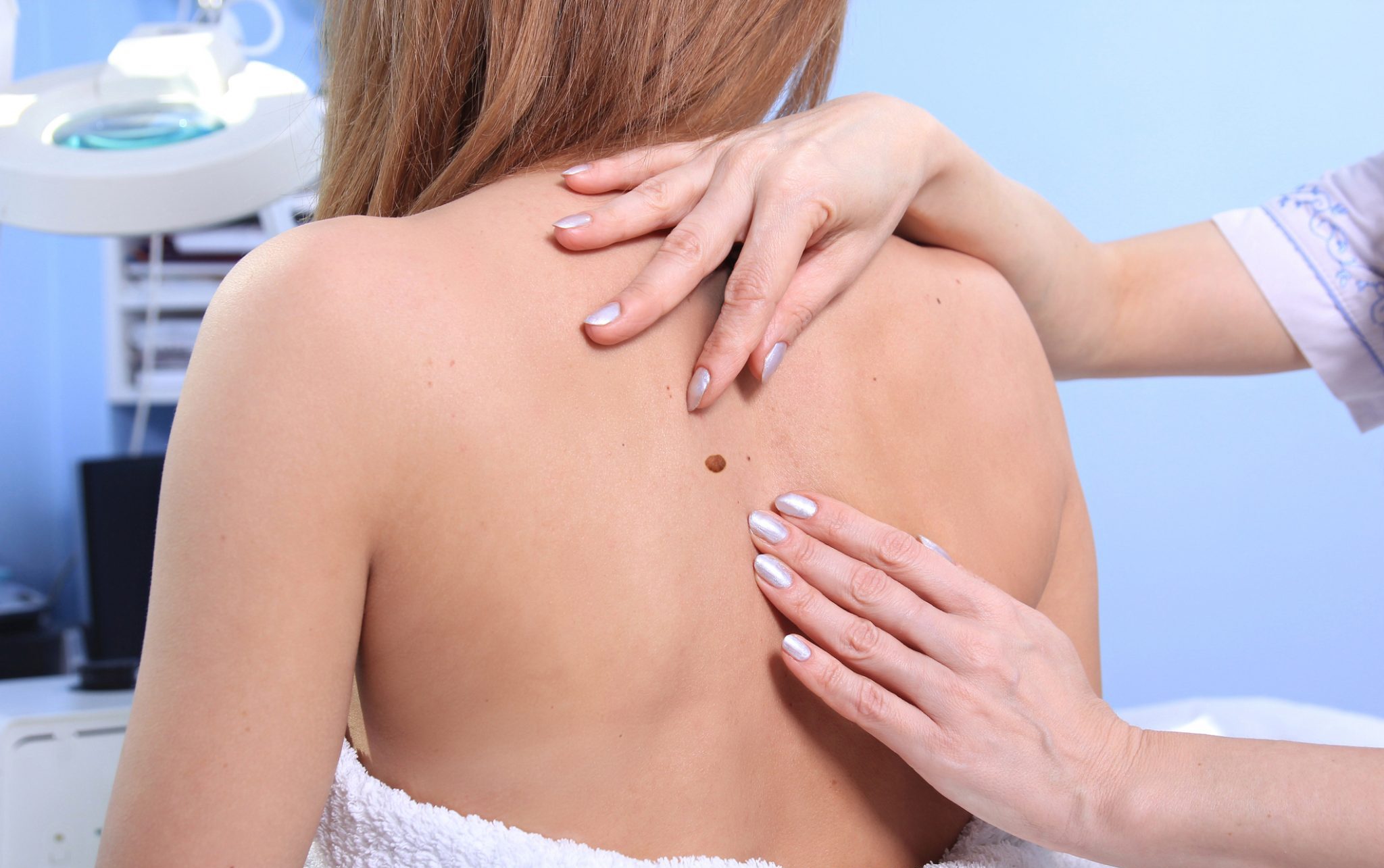Warning! This post contains images of skin cancer which some readers may find unpleasant.
Is that mole just a mole or could it be something else? If you’ve ever worried about a freckle, mole, birthmark, or skin imperfection, one of the thoughts that may have crossed your mind is “is it cancerous?”, and you’re not alone. Many are concerned that after some time in the sun or those ever-sinful sunbeds they could be at risk. With 9,500 people diagnosed every day in the US, getting that mark checked out, might just be a good plan after all, especially as early detection can help prevent progression.
Below we’ll help you discover the early signs of skin cancer, what to look for, and when you really need to get checked.
Types of skin cancer
There are three primary types of skin cancer that you need to be on the lookout for, they are:
Basal cell carcinoma
This type of skin cancer occurs through a DNA mutation in the skin’s basal cells. It might appear as a white, skin-colored, or pink bump, a dark or white and waxy colored lesion, a reddish, scaly patch on the skin. Although it can happen anywhere on your body, the most likely places to see basal cell carcinoma is your head, neck and upper body, where you have been exposed to the sun.
Squamous cell carcinoma
SCC is a type of skin cancer that you may be able to feel under your skin, usually appearing as a bump under your surface, or a crusty, red area on its top. Generally, it is slow-growing, so if caught in time, it is usually easy to treat. However, if left, it may spread to other areas such as the bones, tissues, and lymph nodes where treatment becomes more difficult.
Melanoma
In terms of skin cancer, this is the one you’ve probably heard most about. Melanoma is one of the more severe styles. It develops in the melanocytes, the cells that produce melanin. Although the sun may be a factor in melanoma development, the signs of this cancer can occur elsewhere on the body. You may notice changes to your moles or even new and strange pigment changes on your skin.
However, these are not the only types, less common types include Kaposi sarcoma, Merkel cell carcinoma, and sebaceous gland carcinoma. If you are concerned about a mark on your body that doesn’t fit the descriptions above, you should get it checked.
The self-check you can’t miss
You know your body best, every lump and bump, every hair and mole, and that’s why the best person to check for the beginning signs of skin cancer is YOU. One of the first things you should do right now (or later when you’re at home) is have a look at your own skin.
Take note of any unusual blemishes, moles or spots that might stand out. Below we’ll tell you more of exactly what to look for. Even if your skin appears to be healthy right now, having this information in our mind’s eye means you are more likely to be able to identify future changes.
Self-check FAQs:
Where should I look?
Many believe that the visual signs of skin cancer appear only on the face, where you are primarily exposed to sun, but this isn’t quite correct. Although it is more likely that you will see some signs on your face, neck and décolletage (shoulder-area), make sure to check your entire body including your lips, scalp, chest, arms, legs, hands, and feet. In rare cases, signs have been known to appear under your nails, on the palms of your hands, and in the genital region. Making a full-body check a must.
When should I check?
There’s no better time than the present. Whenever you get home from that long day at the office, treat yourself to a nice warm bath or shower if you prefer (this is not essential, but there’s no harm in a little bath-time relaxation), as you dry yourself off, pay close attention to your body. The first thing you need to do is note any freckles, marks or moles that you have, or you don’t remember seeing before.
What should I look for?
As you complete the once-over of your body, these are the things you need to note that could indicate skin cancer:
- New moles or growths – Do you see any moles where you never had them before? Do you feel a bump or lump just under the surface of your skin? Or, there is something else that doesn’t look quite right?
- Change to your moles, freckles or skin marks – Changes to moles are one of the early signs of skin cancer; they can look larger than before, you may see changes to their edges, a new texture (bumpy, cracked) or color.
- Lesions or redness on your skin – Do you have a patch of skin that looks red and scaly, or simply cracked? Perhaps there’s an area in particular that itches or bleeds, and you don’t know the cause?
- Dark patches or lesions – Are you seeing a dark brown patch on your skin, particularly around your palms, fingertips, toes or the soft, internal tissue of your mouth, nose, or genital area?
- Smaller, colored lesion – Do you see a small bumpy skin imperfection? Perhaps it has a blue, red, white, or skin-colored tone? But you feel something isn’t quite right about it.
ABCDE for moles
You’ve probably heard of this method before. As moles can be one of the critical indicators of skin cancer, the best way to catch it early is to keep an eye on them, and to do that you should use the ABCDE guide:
- A – Asymmetry. When dividing a mole in half with a theoretical line, both sides don’t match.
- B – Border. The edges of your mole are uneven, raised or even crusty.
- C – Color. You notice color changes, your mole is uneven in color, or may even look red or blue.
- D – Diameter. The size of your mole is quite large, more than 6mm, or it has recently grown.
- E – Evolving. Your mole is changing in size, color, shape, or begins to bleed.
Risk factors
Environmental, genetic, and behavioral; these are the risks you need to watch out for to help lower and key an eye on your risk of skin cancer:
- Family history – If someone in your family has had skin cancer before, this makes it more likely that you could get it too in the future.
- Fair skin – The lighter your skin, the more sensitive it is to the sun’s rays. That’s because you have less melanin (pigment) which offers protection.
- You’ve had it before – If you’ve had skin cancer before, it’s possible it could reappear, and not just in the same place, so keep a watch out.
- Sun exposure and burns – That all-day sunbathing isn’t such a great plan. Increased sun exposure can multiply your risk, especially if it’s accompanied by that painful burn.
- Altitude – If you’re a fan of the mountains, love snowboarding, or simply live in a higher place, you could be at an increased risk. Living in higher altitude environments means those sun rays take less time to reach you.
- Immune system– If your immune system has been weakened by disease or you are taking specific medications, such as those that suppress the immune system after a transplant, you might find yourself more vulnerable to the sun’s rays.
Myths dispelled
We’ve all heard these before, whether from a friend, colleague, your aunt, uncle, parents, or even yourself. Here’s why these “excuses” don’t fly:
“I always wear sunscreen, so I won’t get cancer.”
While wearing sunscreen decreases your risk, there are a number of essential factors you need to pay attention to. First, there are other risk factors, such as genetic predisposition, having skin cancer before, and others that increase your risk.
Further to that, just because you’re wearing sunscreen doesn’t mean it’s the right one. You need to look for a brand that protects from UVA and UVB rays and has an appropriate SPF – the higher, the better. Remember to reapply at regular intervals and after you’ve been in the water.
“If I had cancer, I’d feel sicker.”
In its early stages, you might not “feel” the effects of skin cancer, but that doesn’t mean it isn’t there. For many people, the first signs may be purely visual – an odd lump or bump, for some, these areas may be painful, for others, not at all. Soreness is not an indicator of illness.
“I’m dark-skinned, I can’t get skin cancer.”
While there is a lower risk of skin cancer for those with darker skin, there is not zero risk. People of all races can get the disease, and those with dark skin may find it harder to detect in its early stages.
“I can’t wear sunscreen; I need that vitamin D.”
Yes, vitamin D is one of those essentials that you need to have in your diet and a deficit can make you feel very unwell, BUT that doesn’t mean you need to cook yourself under the sun’s searing rays to get it. While a little bit of sun doesn’t hurt, you should seek sources of vitamin D from your diet – oily fish, dairy, egg yolks, liver, to name a few.
“I’m not old enough to get it.”
One of the most serious forms, melanoma, is the 2nd most common form of cancer among young adults (aged 25 to 29). With one in five people in the US developing the disease before 70. Meaning you’re never too young to be at risk.
What to do next?
If you’ve spotted an odd mole or blemish, the best thing you can do right now is head to your doctor – depending on where you are in the world this might be your primary care physician or directly to a dermatologist. Seeking treatment in the first stages of skin cancer often has very good success rates, so the sooner, the better.
They will be able to examine your problem area, take some bloods and get to the bottom of what’s going on. From there they may advice specific treatment measures to help get you healthy again.
However, if you’ve checked, and the doctor’s checked and nothing is amiss, then the best thing you can do is prevent, not cure with these quick top tips:
- Stay out of the midday sun. From around 10 am to 4pm, the sun is at its strongest in the sky, meaning basking in those waves could do more damage to your skin.
- Apply sunscreen. Whether you’re heading out for a walk, sitting on the beach, or even driving, you need to apply that sunscreen regularly. Aim for a high factor SPF 30+ and keep reapplying throughout the day.
- Use protection. While you might be sweating even with a minimal amount of clothes, if that sun is heavy you may need a little extra protection. Covering your body from arm to toe, with a hat included in a light fabric, could be the best way to save yourself from sunburn.
- Take note of your medication. Some medication can make your skin extra sensitive to skin cancer. Check with your doctor and if it does use extra protection.
- Keep an eye on your body. We’ve said it before, knowing your body is your best weapon, so keep an eye on any irregularities and report them to your physician ASAP.

